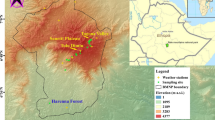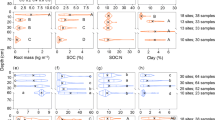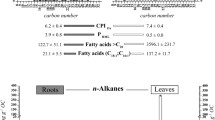Abstract
Cutins of plant shoots and suberins, mostly present in roots could contribute to significant portions of stable soil organic matter. Their biomarker potential, residing in their unique compositions in different plant types, has been used previously to infer sources of organic matter in sediments. These aliphatic plant biopolyesters contain specific biomarkers, which may be used for tracing their fate in soils and sediments, when combined with stable 13C isotope labelling. In order to evaluate the potential use of cutin and suberin biomarkers as indicators of shoot and root contributions from C3 and C4 plant origins, the objectives of this study were to 1) identify their constitutive monomers, which are specific for shoots and roots of maize (C4) and wheat (C3); 2) evaluate the 13C differences between maize and wheat biomarkers. Mid-chain hydroxy carboxylic acids were mainly found in the aboveground biomass, while α,ω-alkanedioic acids were only present in the roots. The differences in the isotopic composition of the specific monomers between wheat and maize plants (17–18‰ for shoot markers, 19‰ for root markers) were larger than those observed for bulk plant tissues and close to those observed for lignin-derived phenols in other studies. These differences should make it possible to differentiate and quantify the different types and sources of organic matter in sediments and soils. In particular, the molecular and isotopic signatures of cutins and suberins can be used to evaluate the specific dynamics of root vs shoot tissues in soils using C3/C4 chronosequences.




Similar content being viewed by others
References
Almendros G, Dorado J, Sanz J, Alvarez-Ramis C, Fernandez-Marron MT, Archangelsky S (1999) Compounds released by sequential chemolysis from cuticular remains of the Cretaceous Gymnosperm Squamastrobus tigrensis (Patagonia, the Argentine). Org Geochem 30:623–634
Amelung W, Brodowski S, Sandahge-Hofmann A, Bol R (2008) Combining biomarker with stable isotope analyses for assessing the transformation and turnover of soil organic matter. In: Sparks DL (ed) Advances in agronomy, vol 100. Academic Press, Burlington, p 155
Augris N, Balesdent J, Mariotti M, Derenne S, Largeau C (1998) Structure and origin of insoluble and non-hydrolysable, aliphatic organic matter in a forest soil. Org Geochem 28:119–124
Badeck FW, Tcherkez G, Nogués S, Piel C, Ghashghaie J (2005) Post-photosynthetic fractionation of stable carbon isotopes between plants organs—a widespread phenomenon. Rap Commun Mass Spectrom 19:1381–1391
Bahri H, Dignac M-F, Rumpel C, Rasse DP, Chenu C, Mariotti A (2006) Lignin turnover kinetics in an agricultural soil is monomer specific. Soil Biol Biochem 38:1977–1988
Balesdent J, Mariotti A (1996) Measurement of soil organic matter turnover using 13C natural abundance. In: Boutton TW, Yamasaki S (eds) Mass spectrometry of soils. Marcel Dekker, New York, pp 83–111
Bernards MA (2002) Demystifying suberin. Can J Bot 80:227–240
Bull ID, Nott CJ, van Bergen PF, Poulton PR, Evershed RP (2000) Organic geochemical studies of soils from the Rothamsted classical experiments. VI. The occurrence and source of organic acids in an experimental grassland soil. Soil Biol Biochem 32:1367–1376
Caldicott AB, Eglinton G (1976) Cutin acids from bryophytes: an ω-1 hydroxy alkanoic acid in two liverwort species. Phytochem 15:1139–1143
Cardoso JN, Eglinton G (1975) The use of cutin acids in the recognition of higher plant contribution to recent sediments. In: Campos R, Goni J (eds) Advances in organic geochemistry. Enadimsa, Madrid, pp 273–287
Cardoso JN, Eglinton G (1983) The use of hydroxyacids as geochemical indicators. Geochim Cosmochim Acta 47:723–730
Chikaraishi Y, Naraoka H, Simon RP (2004) Hydrogen and carbon isotopic fractionations of lipids biosynthesis among terrestrial (C3, C4 and CAM) and aquatic plants. Phytochem 65:1369–1381
Dean BB, Kolattukudy PE (1976) Synthesis of suberin during wound-healing in jade leaves, tomato fruit, and bean pods. Plant Physiol 58:411–416
del Rio JC, Hatcher PG (1998) Analysis of aliphatic biopolymers using thermochemolysis with tetramethylammonium hydroxide (TMAH) and gas chromatography-mass spectrometry. Org Geochem 29:1441–1451
Derrien D, Marol C, Balesdent J (2006) Microbial biosynthesis of individual neutral sugars among sets of substrates and soils. Geoderma 139:190–198
Dignac M-F, Bahri H, Rumpel C, Rasse DP, Bardoux G, Balesdent J, Girardin C, Chenu C, Mariotti A (2005) Carbon-13 natural abundance as a tool to study the dynamics of lignin monomers in soil: an appraisal at the Closeaux experimental field (France). Geoderma 128:3–17
Dinel H, Schnitzer M, Mehuys GR (1990) Soil lipids: origin, nature, content, decomposition, and effect on soil properties. In: Bollag M, Stotzky G (eds) Soil biochemistry, vol 6. Marcel Dekker, New-York, pp 398–429
Eglinton G, Hunneman DH, McCormick A (1968) Gas chromatographic-mass spectrometric studies of long chain hydroxy acids. Org Mass Spectrom 1:593–611
Espelie KE, Kolattukudy PE (1979) Composition of the aliphatic component of ‘suberin’ from the bundle sheaths of zea mays leaves. Plant Sci Lett 15:225–230
Espelie KE, Dean BB, Kolattukudy PE (1979) Composition of lipid-derived polymers from different anatomical regions of several plant species. Plant Physiol 64:1089–1093
Espelie KE, Davis RW, Kolattukudy PE (1980) Composition, ultrastructure and function of the cutin- and suberin-contaning layers in the leaf, fruit peel, juice-sac and inner seed coat of grapefruit (Citrus paradisi Macfed.). Planta 149:498–551
Franke R, Briesen I, Wojciechowski T, Faust A, Yephremov A, Nawrath C, Schreiber L (2005) Apoplastic polyesters in Arabidopsis surface tissues—a typical suberin and a particular cutin. Phytochem 66:2643–2658
Ghashghaie J, Badeck FW, Lanigan G, Nogués S, Tcherkez G, Deléens E, Cornic G, Griffiths H (2003) Carbon isotope fractionation during dark respiration and photorespiration in C3 plants. Phytochem Rev 2:145–161
Goñi MA, Hedges JI (1990a) Cutin-derived CuO reaction products from purified cuticles and tree leaves. Geochim Cosmochim Acta 54:3065–3072
Goñi MA, Hedges JI (1990b) Potential applications of cutin-derived CuO reaction products for discriminating vascular plant sources in natural environments. Geochim Cosmochim Acta 54:3073–3081
Goñi MA, Hedges JI (1990c) The diagenetic behavior of cutin acids in buried conifer needles and sediments from a coastal marine environment. Geochim Cosmochim Acta 55:3083–3093
Graça J, Schreiber L, Rodrigues J, Pereira H (2002) Glycerol and glyceryl esters of ω-hydroxyacids in cutins. Phytochem 61:205–215
Heredia A (2003) Biophysical and biochemical characteristics of cutin, a plant barrier biopolymer. Biochim Biophys Acta 1620:1–7
Hobbie AE, Werner RA (2004) Intramolecular, compound-specific, and bulk carbon isotope patterns in C3 and C4 plants: a review and synthesis. New Phytol 161:371–385
Holloway PJ (1973) Cutins of Malus pumila fruits and leaves. Phytochem 12:2913–2920
Holloway PJ, Deas AHB (1973) Epoxyoctadecanoic acids in plant cutins and suberins. Phytochem 12:1721–1735
Hunneman DH, Eglinton G (1971) The constituent acids gymnosperm cutins. Phytochem 11:1989–2001
Jandl G, Leinweber P, Schulten H-R, Ekschmitt K (2005) Contribution of primary organic matter to the fatty acid pool in agricultural soils. Soil Biol Biochem 37:1033–1041
Kögel-Knabner I (2002) The macromolecular organic composition of plant and microbial residues as inputs to soil organic matter. Soil Biol Biochem 34:139–162
Kögel-Knabner I, Ziegler F, Riederer M, Zech W (1989) Distribution and decomposition pattern of cutin and suberin in forest soil. Z Pflanzenernahr Bodenk 152:409–413
Kögel-Knabner I, Hatcher PG, Tegelaar EW, de Leeuw JW (1992) Aliphatic components of forest soil organic matter as determined by solid-state 13C NMR and analytical pyrolysis. Sci Total Environ 113:89–106
Kolattukudy PE (1981) Structure, biosynthesis, and biodegradation of cutin and suberin. Annu Rev Plant Physiol 32:539–567
Kolattukudy PE (1984) Biochemistry and function of cutin and suberin. Can J Bot 62:2918–2933
Kolattukudy PE, Walton TJ (1972) The biochemistry of plant cuticular lipids. Prog Chem Fats Lipid 13:119–175
Kunst L, Samuels AL (2003) Biosynthesis and secretion of plant cuticular wax. Prog Lipid Res 42:51–80
Matzke K, Riederer M (1990) The composition of the cutin of the caryopses and leaves of Triticum aestivum L. Planta 182:461–466
Matzke K, Riederer M (1991) A comparative study into the chemical constitution of cutins and suberins from Picea abies (L.) Karst., Quercus robur L. and Fagus sylvatica L. Planta 185:233–245
Melzer E, Schmidt HW (1987) Carbon isotope effects on the pyruvate dehydrogenase reaction and their importance for relative carbon-13 depletion in lipids. J Biol Chem 262:8159–8164
Mendez-Millan M, Dignac M-F, Rumpel C, Derenne S (2010) Quantitative and qualitative analysis of cutins in plants and soils: comparison of CuO oxidation, transmethylation and saponification methods. Org Geochem 41:187–191
Molina I, Bonaventure G, Ohlrogge J, Pollard M (2006) The lipid polyester composition of Arabidopsis thaliana and Brassica napus seeds. Phytochem 67:2597–2610
Naafs DFW, Van Bergen PF (2002) Effect of pH adjustments after base hydrolysis: implications for understanding organic matter in soils. Geoderma 106:191–217
Nierop KGJ (1998) Origin of aliphatic compounds in a forest soil. Org Geochem 29:1009–1016
Nierop KGJ, van Lagen B, Buurman P (2001) Composition of plant tissues and soil organic matter in the first stages of a vegetation succession. Geoderma 100:1–24
Nogués S, Tcherkez G, Cornic G, Ghashghaie J (2004) Respiratory carbon Metabolism following illumination in intact French bean leaves using 13C/12C isotope labeling. Plant Physiol 136:3245–3254
Otto A, Simpson MJ (2006) Sources and composition of hydrolysable aliphatic lipids and phenols in soils from western Canada. Org Geochem 37:385–407
Otto A, Shunthirasingham C, Simpson MJ (2005) A comparison of plant and microbial biomarkers in grassland soils from the Prairie Ecozone of Canada. Org Geochem 36:425–448
Park R, Epstein S (1961) Metabolic fractionation of C13 & C12 in plants. Plant Physiol 36:133–138
Quenea K, Largeau C, Derenne S, Spaccini R, Bardoux G, Mariotti A (2006) Molecular and isotopic study of lipids in particle size fractions of a sandy cultivated soil (Cestas cultivation sequence, southwest France): Sources, degradation, and comparison with Cestas forest soil. Org Geochem 37:20–44
Rasse DP, Rumpel C, Dignac M-F (2005) Is soil carbon mostly root carbon? Mechanisms for a specific stabilisation. Plant Soil 269:341–356
Ray AK, Lin YY, Gerard H, Chen Z-J, Osman SF, Fett WF, Moreau RA, Stark RE (1995) Separation and identification of lime cutin monomers by high performance liquid chromatography and mass spectrometry. Phytochem 38:1361–1369
Riederer M, Matzke K, Ziegler F, Kögel-Knabner I (1993) Occurrence, distribution and fate of the lipid plant biopolymers cutin and suberin in temperate forest soils. Org Geochem 20:1063–1076
Rossmann A, Butzenlechner M, Schmidt HW (1991) Evidence for a nonstatistical carbon isotope distribution in natural glucose. Plant Physiol 96:609–614
Smith NS, Epstein S (1971) Two categories of 13C/12C Ratio for higher plants. Plant Physiol 47:380–384
Sollins P, Homann P, Cadwell BA (1996) Stabilisation and destabilisation of soil organic matter mechanism and control. Geoderma 74:65–105
Tcherkez G, Nogués S, Cornic G, Badeck FW, Ghashghaie J (2003) Metabolic origin of carbon isotope composition of leaf dark-respired CO2 in French bean. Plant Physiol 131:237–244
Velcheva MP, Espelie KE, Ivanov CP (1981) Aliphatic composition of cutin from inner seed coat of apple. Phytochem 20:2225–2227
Wiesenberg GLB, Schwarzbauer J, Schmidt MWI, Schwark L (2004a) Source and turnover of organic matter in agricultural soils derived from n-alkane/n-carboxylic acid compositions and C-isotope signatures. Org Geochem 35:1371–1393
Wiesenberg GLB, Schwark L, Schmidt MWI (2004b) Improved automated extraction and separation procedure for soil lipid analyses. Eur J Soil Sci 55:349–356
Zeier J, Schreiber L (1998) Comparative investigation of primary and tertiary endodermal cell walls isolated from the roots of five monocotyledoneous species: chemical composition in relation to fine structure. Planta 206:349–361
Zeier J, Ruel K, Ryser U, Schreiber L (1999) Chemical analysis and immunolocalisation of lignin and suberin in endodermal and hypodermal/rhizodermal cell walls of developing maize (Zea mays L.) primary roots. Planta 209:1–12
Zimmermann HM, Hartmann K, Schreiber L, Steudle E (2000) Chemical composition of apoplastic transport barriers in relation to radial hydraulic conductivity of corn roots (Zea mays L.). Planta 210:302–311
Acknowledgements
This research was made possible through a grant from the ‘Ministère délégué à la Recherche et aux Nouvelles Technologies’—ACI no. JC10052. The authors wish to thank Gérard Bardoux for technical support during chromatographic and isotopic analysis. We thank two anonymous reviewers and Jeremy Jacob for their constructive comments.
Author information
Authors and Affiliations
Corresponding author
Rights and permissions
About this article
Cite this article
Mendez-Millan, M., Dignac, MF., Rumpel, C. et al. Can cutin and suberin biomarkers be used to trace shoot and root-derived organic matter? A molecular and isotopic approach. Biogeochemistry 106, 23–38 (2011). https://doi.org/10.1007/s10533-010-9407-8
Received:
Accepted:
Published:
Issue Date:
DOI: https://doi.org/10.1007/s10533-010-9407-8




